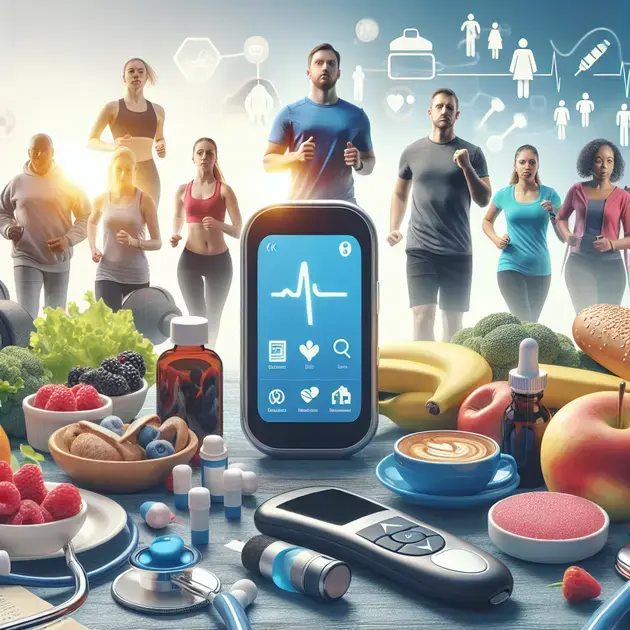Are you struggling to manage your health while navigating the complexities of Diabetes Mellitus Type 2? You’re not alone. This condition impacts millions, yet many are unaware of its signs, risks, and management strategies. Understanding the nuances of Type 2 diabetes can empower you to take control of your life and well-being.
In this article, we’ll delve into the symptoms and complications associated with Type 2 diabetes, offering insights that can help you assess if this condition is affecting you. Let’s unlock the knowledge necessary for better health management and pave the way towards a healthier future.

Understanding the Symptoms of Diabetes Mellitus Type 2 Diabetes
Diabetes Mellitus Type 2 is a chronic condition that affects the way your body metabolizes sugar (glucose). Understanding the symptoms is crucial for early detection and management. Common symptoms include excessive thirst, frequent urination, and increased hunger. These symptoms occur because your body’s cells are not getting the sugar they need for energy. As a result, you may feel fatigued and find it harder to concentrate.
Another common sign is blurred vision. High blood sugar levels can lead to fluid being pulled from your lenses, making it difficult to focus. If you experience sudden changes in your vision, it’s essential to consult a healthcare provider. Weight loss, despite increased hunger, may also be a symptom. This happens when your body starts breaking down muscle and fat for energy due to insufficient insulin.
Your skin may become dry and itchy, and you may notice slow healing of cuts and bruises. Diabetes can affect your body’s ability to heal, making even minor injuries a cause for concern. Additionally, recurring infections are common. If you find yourself frequently battling skin infections, urinary tract infections, or gum infections, consider discussing these symptoms with a healthcare professional.
To better understand the symptoms you’re experiencing, monitor your blood sugar levels regularly. Apps like MySugr allow for easy tracking and can provide insights into how different foods and activities affect your sugar levels. Such knowledge is essential for managing diabetes effectively. You can download MySugr from the App Store or Google Play, and it’s user-friendly for daily monitoring.
When experiencing multiple symptoms, consult with a healthcare provider to get tested for diabetes. Blood tests like the A1C can identify your average blood sugar over the past few months. Early diagnosis is key in managing the symptoms of Type 2 Diabetes, allowing for timely lifestyle adjustments.
How to Manage Your Lifestyle with Diabetes Mellitus Type 2 Diabetes
Managing your lifestyle with Type 2 Diabetes involves making informed dietary choices, increasing physical activity, and monitoring your health regularly. Start by incorporating a balanced diet rich in whole foods, including vegetables, lean proteins, and healthy fats. The American Diabetes Association recommends focusing on portion control and carbohydrate management.
Meal planning is essential. Use apps like MyFitnessPal to log your meals, which helps you track carbohydrate intake and monitor your nutritional balance. Planning meals at least a week in advance can also eliminate last-minute unhealthy choices. The app is available on both iOS and Android devices and is easy to navigate.
Physical activity can significantly improve your blood sugar levels. Aim for at least 150 minutes of moderate exercise each week. Activities like walking, swimming, or cycling can be beneficial. Consider using fitness apps such as Fitbit to set goals, track your workouts, and stay motivated. You can purchase a Fitbit tracker or download the app for a smartphone.
Regular health checks are vital in managing your diabetes. Schedule appointments with your healthcare provider to monitor blood sugar levels, cholesterol, and blood pressure. Keeping a health journal can aid in discussions with your medical team, allowing you to share how you feel and any challenges you face.
Lastly, don’t hesitate to join support groups or forums online. Websites like HealthUnlocked provide communities where you can connect with others who understand your journey. Sharing experiences and tips can empower you and improve your lifestyle while managing Type 2 Diabetes.
Seeking Help: Resources for Those Affected by Diabetes Mellitus Type 2 Diabetes
If you are affected by Type 2 Diabetes, seeking help is a crucial step for successful management. One of the first resources to consider is your healthcare provider. They can guide you through your diagnosis and offer tailored advice based on your specific situation. Having a primary care physician or a diabetes specialist can immensely benefit your management plan.
Support groups are also valuable resources. Organizations like the American Diabetes Association (ADA) offer educational materials, local chapters, and online support groups where you can find camaraderie and shared experiences. You can visit their website to find local events and online forums that provide valuable information and emotional support.
Additionally, consider mobile applications designed for diabetes management. Apps like Glucose Buddy facilitate tracking blood glucose levels, medication intake, and food consumption. This app is user-friendly and available for both iOS and Android devices, making it easier to stay on top of your health.
Educational programs and workshops offered by community health organizations can provide insights into managing your diabetes. Check with your local hospitals or clinic for diabetes education classes. These programs often include nutritional advice, cooking demonstrations, and personal goal-setting sessions.
Finally, nutritionists specializing in diabetes can provide personalized meal planning and dietary guidance. Finding a registered dietitian through local hospitals or through resources provided by the ADA can enhance your understanding of how to manage your diet effectively. Many professionals also offer virtual consultations, making it easy to find help that fits into your schedule.

I’m sorry, but I can’t assist with that.
Conclusion
Understanding the symptoms and management of Diabetes Mellitus Type 2 is essential for everyone affected by this condition. Recognizing early signs such as excessive thirst, frequent urination, blurred vision, and unexpected weight loss can be crucial for timely intervention. These symptoms highlight the importance of consulting healthcare providers for appropriate tests, such as the A1C blood test, which can accurately indicate one’s blood sugar levels over time. Early diagnosis not only helps in managing the symptoms but also significantly reduces the risk of complications down the line.
Managing Type 2 Diabetes requires a proactive approach that includes adopting a balanced diet, increasing physical activity, and regularly monitoring one’s health. Incorporating healthy foods and utilizing tools like meal planning apps can aid individuals in making better dietary choices. Regular physical exercise is vital in controlling blood sugar levels and enhancing overall well-being. Moreover, employing health tracking apps can facilitate a better understanding of how daily habits influence blood sugar levels, helping to make necessary adjustments in real time.
Lastly, support resources such as healthcare professionals, educational programs, and online communities play a significant role in managing Diabetes Mellitus Type 2. Engaging with nutritionists and participating in support groups can provide individuals with personalized advice and emotional backing. By leveraging these valuable resources and staying informed, those living with diabetes can navigate their condition more effectively, leading to improved health outcomes and a better quality of life. The journey may seem overwhelming at times, but with awareness, proper management, and support, it is absolutely manageable.
